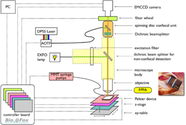The development of programmable parallel microscale feedback control
systems requires a system capable of monitoring and actuating numerous microscopic reaction sites in parallel, while maintaining steady flows of resources. These are also the requirements for the Omega Machine in the PACE project.
The overall experimental set-up involves a fluorescence monitoring system based on a parallel confocal wide-field microscope (Olympus BX51) and an actuation system based on our digital biochip environment - the Field Programmable Fluid Array (FPFA). A schematic is shown adjacently. The parallel feedback setup involves also high performance pumps controlled via serial-interfaces, an EMCCD-camera for image acquisition (Andor), motorized stepper xy- and z-stages (Prior, PI), various solid state laser sources (Coherent DPSS 488 nm, 200 mW and Lasos 639 nm, 25 mW) as well as a microlens spinning disk confocal unit (Yokogawa CSU10). All components are managed by a custom designed and built controller board and a Linux host-computer.

An adapter frame allows controlled temperature-gradients on–chip as well as two different types of FPFA. The setup was optimized for high magnification objectives which limits allowed working-distances. A small PCB with a connector provides control of the Field Programmable Gate Array (FPGA) and/or the electrodes on the FPFA. The adapter is modular and allows the mounting inside a 80 x 80 cm² cartridge for standard z-stage devices as well as in an optical slide and a special minimum-size cartridge. The thermal capacity of the carrier is minimized and supports a quick temperature cycling and cooling to relatively low temperatures. Two temperature-sensors are integrated into the carrier, additional ones can be attached.


